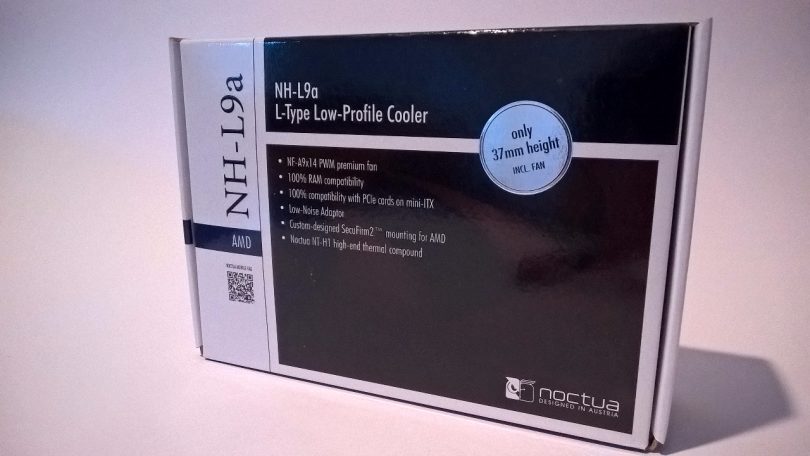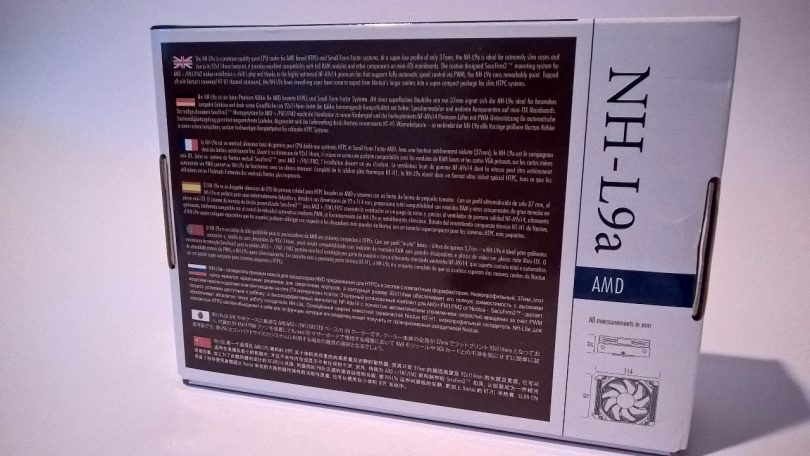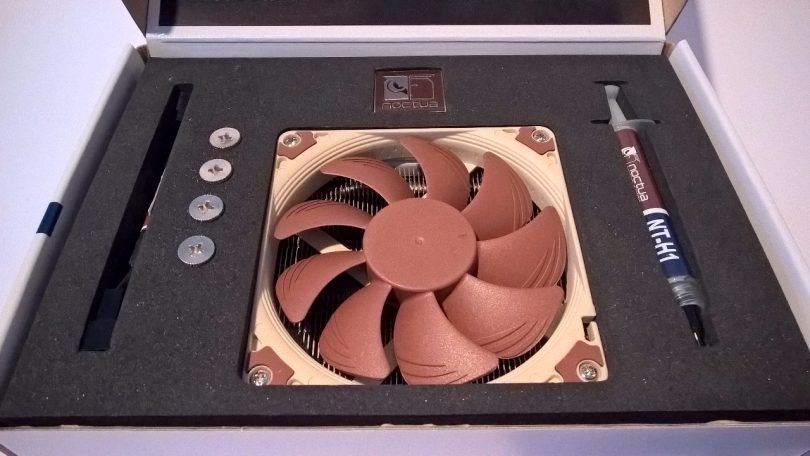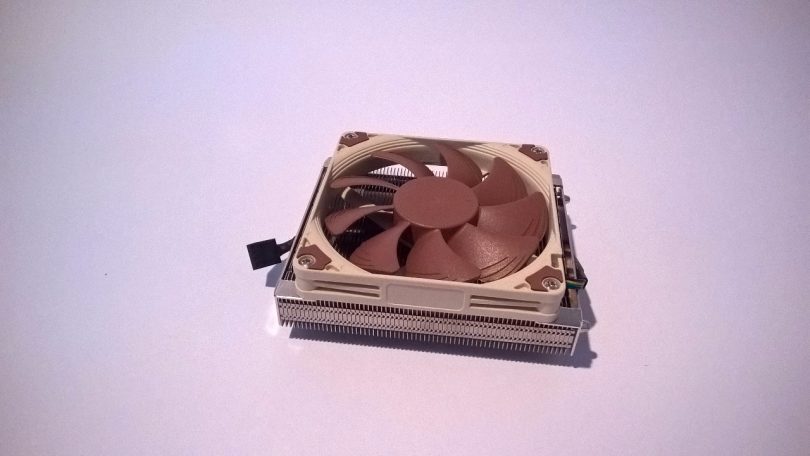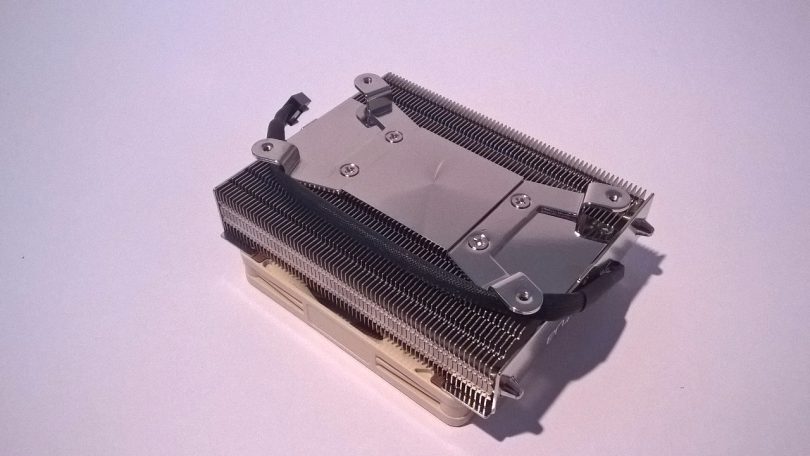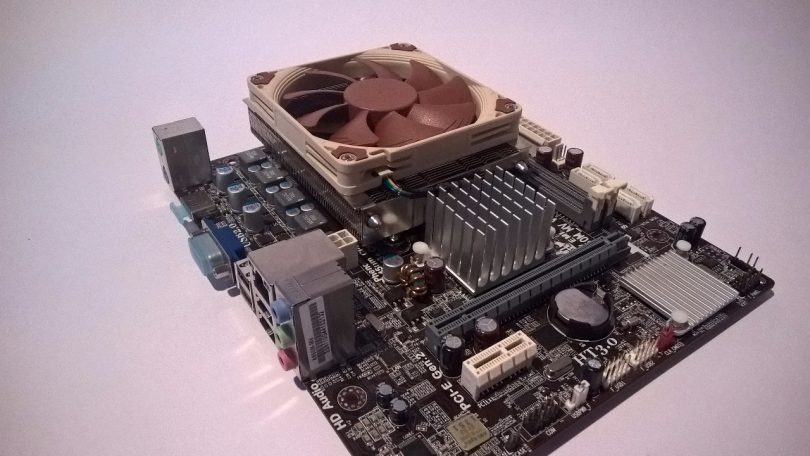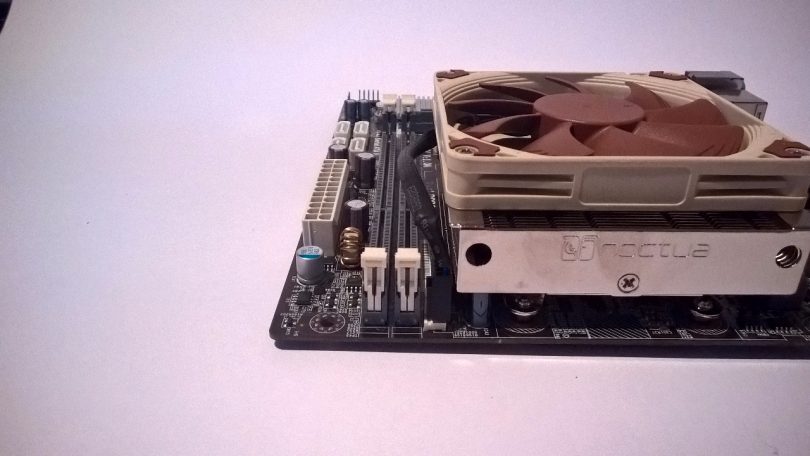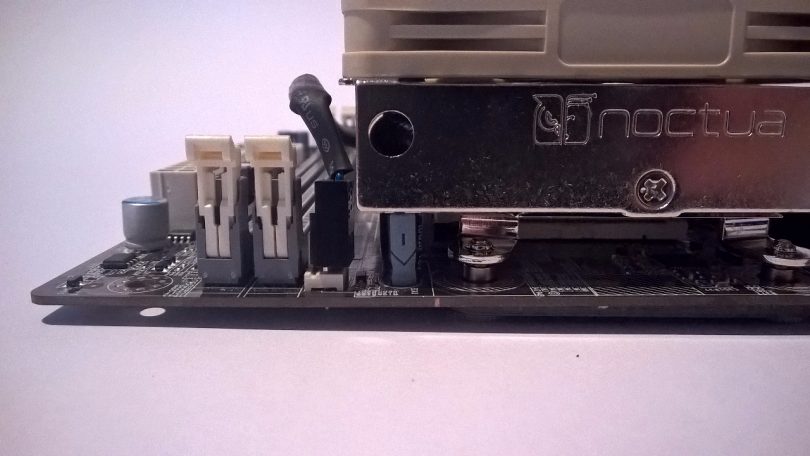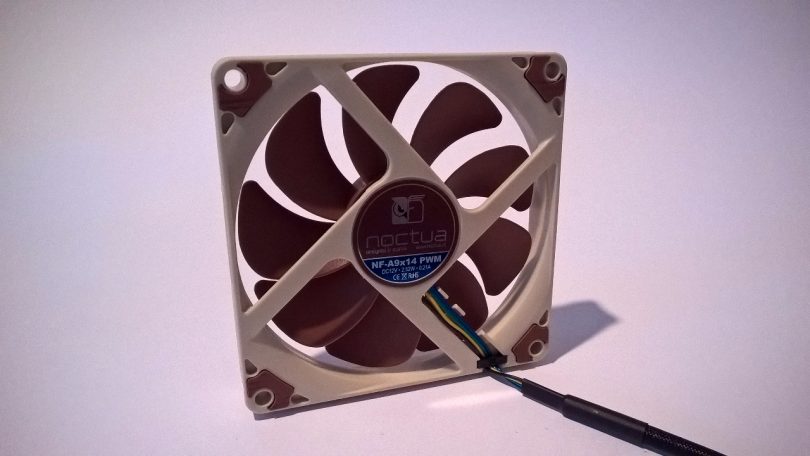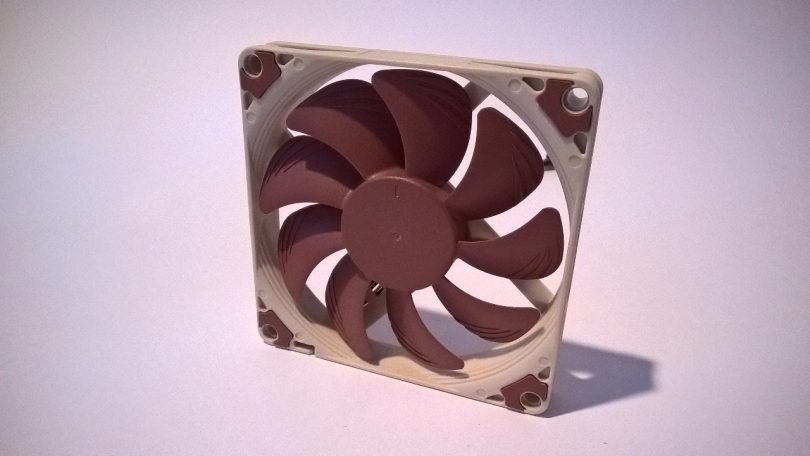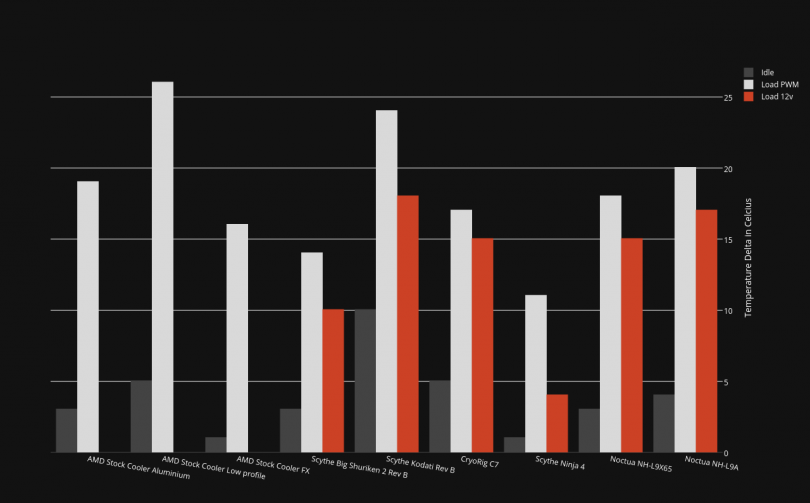In the world of CPU coolers, one name stands out as the ‘premium’ brand in the minds of most PC enthusiasts – Noctua. Today, then, we’ll be looking at one of their SFF-orientated coolers, the NH-L9a.
The L9a is designed exclusively for AMD sockets (and thus compliments the NH-L9i, designed for Intel platforms), and the 37mm-high profile of the unit is claimed to be compatible with essentially any motherboard layout that has the supported sockets. For a SFF builder, this is good news, since finding a compatible cooler with the right performance characteristics can be among the most challenging parts of designing a build.
We’ll be checking that compatibility, as well as the performance, in this review.
The Noctua NH-L9a
| HEATSINK SPECIFICATION | |
|---|---|
| Dimension ( with fan ) | L92 mm x W114 mm x H37 mm |
| Weight ( with fan ) | 465 g |
| Weight ( without fan ) | 390 g |
| Heat pipes | copper heatpipe x 2 |
| Fin Material | Aluminium |
| Fin Count | 70 pcs (incl steel endplates) |
| Copper Base | Copper nickel plated |
| RAM Height Limit | Unlimited |
| TDP | 65W |
| Replaceable Fan? | Yes |
| FAN SPECIFICATION | |
|---|---|
| Dimension | L92 mm x W192 mm x H14 mm |
| Connector | 4 Pin PWM |
| Rated Speed | 500 ~ 2500 RPM ±10 % |
| Noise Level | 14.8 – 23.6 dBA |
| Air Flow | 24.01 – 33.84 CFM |
| Voltage | 12V |
| Power Consumption | 2.52W |
This product supports AMD AM2, AM2+, AM3, AM3+, FM1, FM2, FM2+.
Unboxing
The usual Noctua styling prevails on this product’s box, with simple graphics and a bulleted list providing highlights of what’s inside.
Multi-lingual marketing is seen here on the back of the box (A magnifying glass is recommended, but not required). There are also a few wireframes, complete with exterior measurements for the heatsink, on the bottom right corner.
Diving right into the box, the top lid opens readily, and we see the heatsink and accessories neatly arranged, and recessed in a block of foam. This is precisely how most products – and especially components such as heatsinks – should be packaged. I can’t praise Noctua enough for utilizing such robust and simple packing material, especially since the cleanness and premium presentation of the inside belies the product’s price point. My partner’s own iPhone 6S wasn’t even packed this well (and that’s saying something for a company as packaging-conscious as Apple)!
As for what’s included, the accessory kit is thorough. On top of the usual Noctua LNA (a fan speed reducing resistor), metal case badge, mounting screws and Noctua NT-H1 thermal paste, we see that a few extra parts are included. Among these are some long screws for replacing the fan with a thicker unit (although this would add height to the cooler), as well as a backplate and insulating washers, which enable you to choose your mounting method. The cooler can be mounted using the included backplate – which is made of sturdy, thick steel – or without, when substituting the backplate with the green washers. The washer mounting method will come in handy for those boards that have components on the backside of the board that conflict with any backplate.
The Cooler
As we look at the cooler itself, one is immediately struck by just how tiny it is. Is proportioned to just fit within the space available, and it shows. This is true to the point where the fins of the heatsink actually extend past the fan on two sides, in a bid to add as much cooling potential and heatsink mass as possible.
The base features a pre-fitted mounting mechanism. This mounting mechanism isn’t Noctua’s Secufirm 2, but that omission is understandable in this instance, as this cooler is designed to be as big as possible without any component conflicts. The base is typically Noctua, with concentric machining marks.
Flipping the heatsink allows for us to see the 68 aluminum fins, and 2 thicker steel end plates, that wrap around the heatpipes. The fan mounts to brackets that are folded over from the end plates, and the holes seen above are threaded to accept the included screws.
Mounted to the board, the cooler really is quite small. In this view, no compatibility issues exist.
In this view, we see only one potential compatibility issue – the cooler just sits on top of the capacitor to the right of the fan plug. We suspect, that this may be an issue with the board’s compliance with AMD’s keep out specifications, however. But even so, we see no interference with components such as memory.
The squished capacitor.
Finally, it is worth noting that the included fan for this cooler is a higher RPM variant of the standalone NH-A9x14 fan. This is not mentioned anywhere in documentation or on Noctua’s website, which we found to be strange (and a but frustrating as we conducted research for this review). We’re not sure why Noctua would produce two fans under the same model number, but with different specifications.
Testing
The SFFN test bench currently includes the following hardware:
- Gigabyte 970-D3P Motherboard
- Phenom II 555BE @ 3.2GHz
- 8GB Crucial DDR3-1600 Value RAM (single DIMM)
- Hitachi 60gb 2.5″ 5400RPM SATA HDD (temporary!)
- Gigabyte R7-360
- Thermal Master 420W Power Supply
- Aluminium Test Bench Chassis
To test this cooler, we relied on relatively simple testing methodologies. Using Deepcool Z3 thermal paste (a budget, but decent performing, paste), we mounted the NH-L9a to our 89w AMD Phenom.
To retrieve idle temps, we booted up Windows, loaded HW Monitor and left the system to idle for 10 minutes. The hottest core was recorded at that time.
To load the CPU, we ran Prime95 Blend, with 2 threads (as our CPU is a dual core part). After 20 minutes of load, we once again took the hottest CPU core at that time.
Finally, we repeated this test while having the CPU fan plugged directly into 12v, waited 10 minutes under load, and recorded the hottest core.
We also measured ambient temperatures and converted all results to Delta T (change from ambient) to normalize the results. The fans were run at ‘Normal’ fan control mode in our motherboard’s BIOS.
As the NH-L9a puts a heavy priority on minimizing the cooler’s size and profile, we went into testing with the understanding that it wasn’t going to lead the pack in terms of performance. And, indeed, as we expected, the NH-L9a isn’t a spectacular performer, generally managing to straddle the line dividing the top and middle third of the temperature range, relative to other coolers. Certainly for use cases that prioritize performance, then, there is better.
However, especially when taking the rated 65w limit into account, the cooler performs admirably in the face of the higher thermal load provided by our test bench. And, during our load tests, the L9a manages to significantly outperform AMD’s own stock low profile cooler, which is taller than the L9a. The recently tested Scythe Kodati is also easily bested, although this isn’t too surprising given that the Kodati has a smaller fan.
During testing, the sound output of the L9a felt very similar to the other cooler we tested, the Noctua NH-L9x65 (review coming soon!). This is not at all suprising, as they use the exact same uprated NF-A9x14 fan. Consequently, the fan was never ‘loud’, and the sound signature was always pleasing and non-obtrusive. That’s quite the achievement, given the fact that our load testing exceeded the TDP of the cooler by a whopping 23%!
Conclusion
The Noctua NH-L9a is an excellent performer, considering it’s size. Being this small, it was always going to be a challenge for it to keep our hot 89W test CPU under control, but the NH-L9a did manage to achieve this – your chassis ambient temperature would have to top 45 degrees celcius for the cooler to hit the AMD thermal limit of 65C.
It isn’t going to win any performance accolades, and the ‘matches-with-nothing’ coffee and cream color scheme of the fan is as divisive as it ever was. But for enthusiasts that want (or need) an ultra-low profile cooler that won’t require untenable temperatures or offensively annoying acoustics, Noctua’s NH-L9a manages to stand out at a very accessible price point given the quality of the product.
Pros
Replaceable fan and support for thicker fans
Well built
Good performance
Cons
Some may dislike the colour scheme of the fan
Machined base may not be optimal in terms of performance.
[mks_separator style=”blank” height=”2″]
This cooler is currently available for around US$39.95 on Amazon.com
[mks_separator style=”blank” height=”2″]
Thoughts? Discuss them in the forum.
[mks_separator style=”blank” height=”2″]
Review sample provided by Noctua.
Here at SmallFormFactor.net we give manufacturers the ability to be part of the community. We offer a right to reply to hardware reviews. If a manufacturer responds, their comments will be posted here.
Noctua’s Jakob Dellinger responds to our question about the fan specification discrepancies:
[mks_pullquote align=”left” width=”800″ size=”18″ bg_color=”#000000″ txt_color=”#ffffff”]The reason why we have decided to use a slower maximum speed for the retail variant of the NF-A9x14 is that many customers use it in areas other than CPU cooling where higher speeds are not required and there may be no option to slow down the fan via PWM. For the CPU coolers, on the other hand, PWM is usually available and we wanted to provide some extra performance headroom for hotter CPUs or environments.[/mks_pullquote]

